Synopsis[1] of “Architecture of the Unexpected: Beyond the Learning Paradigm”
Randall Bass, Georgetown University, U.S.A
Copyright 2023 The Author(s). CC-BY-NC-ND License 4.0 This is an open access work distributed under the terms of the Creative Commons Attribution-NonCommercial-NoDerivatives 4.0 International License, which permits copy and redistribution with appropriate credit. This work cannot be used for commercial purposes and cannot be distributed if the original material is modified.
Abstract
This keynote approached the question of how the Scholarship of Teaching and Learning (SoTL) might play a role in the continued progress of “the learning paradigm,” post-pandemic and into the future. I assert that it was primarily the progress of the learning paradigm—the growth of the multi-layered practices related to good pedagogy and educational caretaking—that provided the essence of higher education’s capacity to survive the pandemic. Given that the future will likely be filled with such disruptions, we need to keep building this “architecture of the unexpected” if we are to positively transform higher education in the midst of these disruptions to be more impactful, relevant, equitable, and inclusive. Using a framework known as “Three Horizons,” I explore the potentially disruptive role that SoTL might serve in this transformation.
Keywords: Learning, Higher Education Transformation
THE PROGRESS OF THE LEARNING PARADIGM
We can think of the pandemic as having arrived somewhere in the middle of a multi-decade arc of progress around what nearly 30 years ago Robert Barr and John Tagg (1995) named “the learning paradigm.” They argued that we were in a transition from an “instructional paradigm,” where our designs were focused on the inputs of instruction, to the “learning paradigm,” where we would prioritize environments that advanced student learning outcomes. In their essay, they illustrate the paradigmatic “shift from instruction to learning” by pairing up a whole range of elements in side-by-side tables (see Table 1 and Table 2, which are included as a selection).
Table 1: Side-by-Side “Comparing Educational Paradigms”—First Set (Barr & Tagg, 1995)
| The Instruction Paradigm | The Learning Paradigm |
| Provide/deliver instruction | Produce learning |
| Transfer knowledge from faculty to student | Elicit student discovery and construction of knowledge |
| Offer courses and programs | Create powerful learning environments |
| Achieve access for diverse students | Achieve success for diverse students |
| Quality of entering students | Quantity and quality of outcomes |
The shift in these values all feel pretty familiar in that they have increasingly become commonplace in higher education, if not yet fully realized. But then there are other features outlined in the paradigm shift that are perhaps not yet so widely distributed, including whether one thinks of overall curricular designs as atomistic versus holistic, or the constant as time versus learning.
Table 2: Side-by-Side “Comparing Educational Paradigms”—Second Set (Barr & Tagg, 1995)
| The Instruction Paradigm | The Learning Paradigm |
| Atomistic, parts prior to whole | Holistic, whole prior to parts |
| Time held constant, learning varies | Learning held constant, time varies |
| Degree equals accumulated credit hours | Degree equals demonstrated knowledge and skills |
| “Live” teacher, “live” students required | “Active” learner required, but not “live” teacher |
| Faculty are primarily lecturers | Faculty are primarily designers |
Although we can find some of these elements present in the higher education sector, they are certainly not yet mainstream. Taking into account more than 30 factors, Barr and Tagg speculated that it would indeed take several decades for this shift to be fully realized. Looking over the course of change since 1995, they certainly did not overestimate that.
However, even if mixed and slow, progress towards the “learning paradigm” has been significant as enormous changes have been taking place across higher education in pedagogy, instructional design, equity and inclusion, curriculum, and assessment. For higher education’s survival of the pandemic disruption, the progress of the learning paradigm provided the baseline competence in educational technologies and digital learning, an effective toolbox of evidence-based pedagogies, and an expanding consciousness for well-being and a community of care in the context of the academic learning environments. As a result, the vast majority of colleges and universities stayed open, served their missions, and valued responding to diverse student needs.
In this sense, higher education had been preparing for the unexpected without entirely realizing it. All this progress was rooted in the knowledge and expertise of teaching professionals and achieved through one form or another of communally held professional practice. SoTL emerged from this arc of activity and was shaped at its origins by the complex interrelationship of faculty practice and student learning. SoTL has been an important contributor to the cultivation of these educational capacities, organized around principles of effective practice, that made adaptation to the pandemic crisis possible.
SOTL AND THE ARCHITECTURE OF THE UNEXPECTED
I want to give this phenomenon a name. I’m calling it the “architecture of the unexpected,” and it is directly related to the progress made toward the learning paradigm. If valuing the capabilities of what we might think of as the new educational paradigm was a critical underpinning of higher education’s adaptation to the crisis that began in 2020, then it is this architecture of the unexpected that we need to expand if we are to prepare for an uncertain future in which potentially calamitous disruptions lie ahead.
In using the term “architecture,” I am not talking about physical structures of campuses[2], but the immaterial structures, processes, and ethos that prepare institutions to adapt to disruptive change. This conceptual and organizational architecture includes institutional beliefs, processes, academic policies, and practices that enable the educational activities of an institution and the experience of students. Yet, in framing this architecture on the unexpected, I want to focus on how those same advances in evidence-based pedagogies and relational practices of care form a new set of core practices that can also be seen as institutional capacities for operating in conditions of uncertainty and complexity. There is an important alignment between institutional capacity to learn and adapt and the capacities we seek to give our students to learn and adapt. That is, the values and frameworks that serve the readiness of institutions for an uncertain future are entirely aligned with—if not identical to—the conditions in which we might best educate all our graduates for navigating a complex and uncertain future.
Extrapolating from the pandemic experience, I’m proposing that the best path to growing such an architecture is to focus on the vectors already pointing towards the strengthening of teaching and learning environments based on evidence-based pedagogies, engaged learning, and a robust vision for a culturally-responsive and equitable quality education. SoTL has a unique role in this architecture. As an inquiry practice grounded in the nuanced contexts of teaching and learning, SoTL sits at the boundary of the expected (measurable outcomes) and the unexpected (the open-ended nature of transformative education). This positions SoTL in unique ways for an educational future that will emerge from this boundary as it embodies a growth mindset that sits at the heart of an architecture for the unexpected.
THE THREE HORIZONS FRAMEWORK
To understand this better, we might turn to a simple but powerful tool for understanding long-term transformation known as the Three Horizons framework (Sharpe, 2013).
Figure 1: The Three Horizons Framework[3]
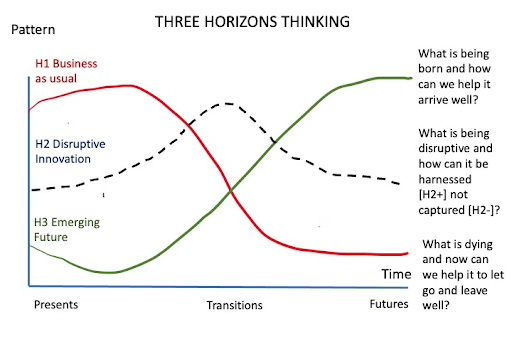
The Three Horizons framework is a way of looking at three dimensions of transformation that are all represented in the present. The first is the current state or dominant paradigm, known as H1. This is “business as usual.” Since the Three Horizons framework is a tool for navigating transitions from one state to another, it is presumed that there are significant dimensions of the H1 paradigm that are no longer “fit for purpose” and have to go away. The second dimension is the emerging paradigm known as H3. This is the future you are hoping to bring into being that will replace H1. Between them is the horizon of disruptive innovation, known as H2, which gives rise to the “dynamics of transition.” Disruptions along the H2 line (intentional or not) either have effect of sustaining H1, in which case the disruption can be thought of as H2-, or have the effect of helping H3 to come into existence, in which case the disruption can be thought of as H2+.
The Three Horizons framework is not predictive. It provides a way to look at the interaction of events and forces that have the potential to effect transitions from one paradigm to another. As the creators put it, like the “five lines of a musical stave,” the Three Horizons framework “is a notation that enables us to express and share the infinite possibilities of transformative innovation” (Sharpe, 2013, p. 28).
The Three Horizons framework is relevant to an architecture of the unexpected in many ways. Most fundamentally, it entails the very nature of making the future present: “Exploring the third horizon is a skill in working creatively with the unknown, the partially known and the uncertain. It is a skill we all have, but have not fully developed as a collective capacity of transformation” (Sharpe, 2013, p. 28).
The Three Horizons also provides a way to think about the role of the pandemic adaptation in Barr and Tagg’s (1995) instructional to learning paradigm transition. Let’s populate the framework using just the terms set out by Barr and Tagg:
Figure 2: Three Horizons Mapping of Barr and Tagg’s “From Teaching to Learning”
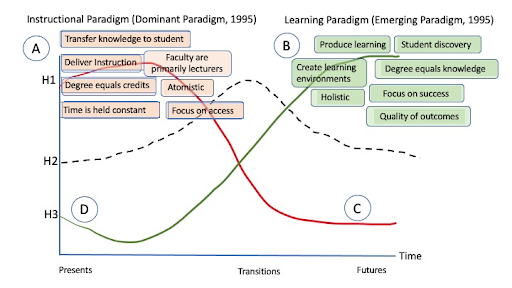
Using Barr and Tagg’s language, the dominant paradigm or “business as usual” would be the instructional paradigm (H1), with the learning paradigm (H3) emerging. In this case, H1, “business as usual” (labeled ‘A’), would focus on the teacher as the primary actor (“transfer of knowledge,” “deliver instruction,” “primarily lecturer”), a focus on inputs (“degree equals credits,” student “access,” and “time” as a constant), and curriculum that is not particularly integrated or coherent (“atomistic”).
On the other hand, H3, the emerging future (labeled ‘B’), focuses the teacher’s role as the creator of “learning environments,” whose purpose is to “produce learning” and lead to “student discovery,” with a focus on outcomes (“success,” “quality of outcomes,” and “degree equals knowledge”). In this emerging future, the approach to curriculum is “holistic.”
The basic populating of the framework could continue to name what aspects of the dominant paradigm need to go away (C) or where there are seeds of the emerging paradigm already in existence (D). The Three Horizons framework allows educators to reframe “educational innovation,” for example, from something that merely reacts to the present (providing solutions to instructional problems) to something that is helping to usher in a desired and emerging future.
The Three Horizons framework does not necessarily lead to one future or another, but it allows a community of practitioners to understand disruption and innovation in light of the paradigm being brought into existence, as opposed to solely being measured against the present paradigm and past practices. Mapping the pandemic as an H2 disruption provides a way for educators and institutional communities to discuss and speculate on the short- and long-term effects of any change or disruption, such as the COVID-19 crisis, on the progress of the many dimensions of the learning paradigm, including quality teaching and learning, student success, and equity and inclusion.
SOTL AS A FORCE OF TRANSITIONS BETWEEN PARADIGMS
This way of mapping also raises the question of whether the emerging future we want or need is sufficiently captured by the defining features of the learning paradigm as Barr and Tagg described them. In 1995, they asserted that the “instruction paradigm” no longer served the needs of higher education. It was, in a phrase, no longer “fit for purpose.” I propose that this “post-pandemic” moment gives us an opportunity to take the measure of the ways that the learning paradigm provided us an “architecture of the unexpected” for the pandemic response. It also allows us to pose questions about what kind of architecture higher education needs to keep preparing for an even more uncertain future. This is where we might begin to imagine the role that SoTL might play in helping not only to accelerate the learning paradigm but in transitioning to something beyond it.
Figure 3: Locating SoTL as a Disruptive Innovation Within the Three Horizons Framework
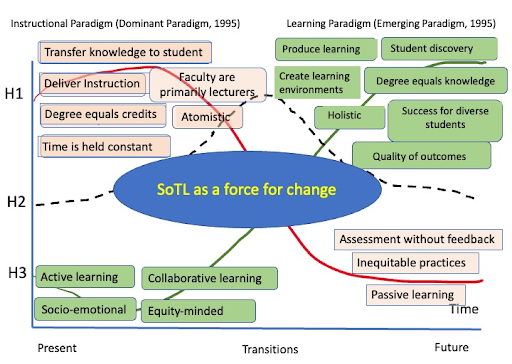
In 2021, in a course I regularly co-teach called “The University as a Design Problem,” our students undertook a thought experiment, asking what it might look like to think beyond Barr and Tagg’s learning paradigm. This impulse grew out of the students’ observations about certain limitations of the “learning paradigm” as Barr and Tagg framed it, despite its positive values. For example, it is still very much tied to the learning of individuals, where the evidence of impact and outcomes resides with individual student success. The learning paradigm could be seen to overemphasize education as a solely private good, evidenced and evaluated only by those outcomes that are most easily quantifiable and contributing to concrete metrics of success. We speculated as to what this might look like. In Table 3, the first two columns are the words of Barr and Tagg; the third column contains the words of my students.
Table 3: Beyond the Learning Paradigm
| The Instruction Paradigm | The Learning Paradigm | Beyond the Learning Paradigm |
| Provide/deliver instruction | Produce learning | Support transformative education |
| Transfer knowledge to students from faculty | Elicit student discovery | Develop change agents |
| Offer courses and programs | Create learning environments | Build partnerships with community for impact |
| Achieve access for diverse students | Achieve success for diverse students | Help redistribute power and privilege |
| Faculty are primarily lecturers | Faculty are primarily designers | Faculty and students are partners, co-designers |
What is at stake in this way of thinking is an alternative and emerging paradigm for higher education. We can use the Three Horizons framework to represent this (see Figure 4). But in order to move towards an educational paradigm that could bring about a “new and better humanity,” we will surely need to start naming what we want the emerging paradigm to be. With limited remaining space here, I’ll turn to a writer who can give us some content for this vision, Laura Rendón (2009), from a piece called “Prelude to a New Pedagogical Dreamfield”:
I join the many existing voices of educational transformation to contribute to the generation of a new tipping point—a movement that wishes to create a new dream of education. The foundation of this dream is a more harmonic, holistic vision of education that honors the whole of who we are as intellectual, compassionate, authentic human beings who value love, peace, democracy, community, diversity, and hope for humanity. (p. 23).
Figure 4: Mapping an Emerging Paradigm in the Three Horizons Framework
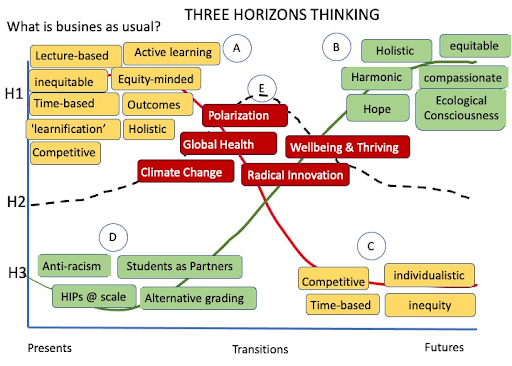
In this forward-looking view, let’s redefine H1 as the current state of the learning paradigm, being a mixed combination of residual practices of the instruction paradigm co-existing with the emergent qualities of the learning paradigm. Here “business as usual” (labeled ‘A’) is characterized by both lecturing and active learning and is both inequitable and equity-minded. The current state is still based on time and credits, but with increased attention to learning outcomes, and although there is interest in holistic approaches to education (both the coherence of curricula and attention to the whole person), there are also powerful tendencies toward what Biesta (2010) calls “learnification,” which seeks to reduce the broad aims of education to increasingly narrow and measurable activities.
Out of this current state of things, there will be elements we want to keep and others that we want to shed (labeled ‘C’). Rendón’s vision is selectively represented here as the H3 future, emphasizing education that is harmonic, holistic, hopeful, and focused on compassion and ecological consciousness (labeled ‘B’). We can certainly find seeds of this emerging future (labeled ‘D’) in any number of progressive educational practices, such as the spread of high-impact practices, the students-as-partners movement, and anti-racism. All of these could plausibly be seen as the continuity of the learning paradigm with whatever will unfold beyond it. The architecture of the unexpected (labeled ‘E’) comes into play with H2, the forces of change and disruption. Here we can imagine disruptions that are external and beyond institutional control, such as the environmental crisis, future global health crises, and increasing polarization and widening inequality, but H2 creative disruptions can also be intentional and serve to stimulate transformation, such as more radical educational innovations or movements towards institutional values, such as “well-being,” that if taken seriously would be radically reframing.
In this framework, we can look at both internal and external disruptive forces and ask how their impact can be progressive (moving us toward an emerging paradigm) rather than regressive (captured by the current dominant paradigm). We can also then pose the same kinds of questions about the future of SoTL (see Figure 5).
Figure 5: Harnessing SoTL as a Disruptive Force
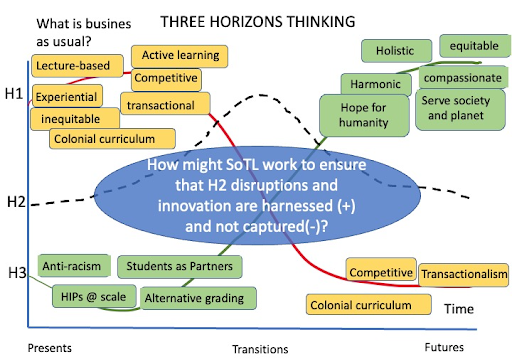
Seen in this context, we can start to interrogate how SoTL can play a disruptive role in the present and a formative role for a desired future. It also helps us see that SoTL’s ethos and practices live in the space of critical transitions between paradigms. The potential for such transitions lies in our capacity as educators to recognize the value of the unexpected in education as a critical capacity for adapting to an uncertain future. This is a space where SoTL can thrive and a role that it can play in the next phase of progress in the fifty-year arc of the learning paradigm and beyond.
[1] This summary is a synthesis of the keynote at the 2022 Scholarship of Teaching and Learning Symposium in Banff, AB, and a written piece by the same name, forthcoming in the volume Recentering Learning (Debelius, Kim, & Maloney, Johns Hopkins University Press, 2024).
[2] This is not to suggest that a focus on physical architecture and adaptation to future climate impacts, for example, would not also be appropriate. For that, see Alexander (2023), among others.
[3] Figures 1-5 are adaptations of Sharpe's (2013) Three Horizons Framework, CC BY-SA 4.0 License 4.0 (Creative Commons Attribution ShareAlike 4.0 International License) which permits sharing and adaptation with appropriate credit.
How to Cite
Bass, R. (2023). Synopsis of "Architecture of the unexpected: Beyond the learning paradigm." Imagining SoTL, 3(1), 2-13. https://doi.org/10.29173/isotl725
Author Biography
Randall Bass (bassr@georgetown.edu) is Vice President for Strategic Education Initiatives and Professor of English at Georgetown University, where he leads an educational innovation unit known as the Red House. He focuses on transformation towards emerging educational paradigms in the context of transgenerational issues such as the environment, AI, and well-being.
References
Alexander, B. (2023). Universities on fire: Higher education in the climate crisis. Johns Hopkins University Press.
Barr, R. B., & Tagg, J. (1995). From teaching to learning—A new paradigm for undergraduate education. Change: The Magazine of Higher Learning, 27(6), 12–26. https://doi.org/10.1080/00091383.1995.10544672
Biesta, G. J. J. (2010). Good education in an age of measurement: Ethics, politics, democracy. Routledge.
Rendón, L. I. (2009). Sentipensante (sensing/thinking) pedagogy: Educating forwholeness, social justice and liberation. Stylus Publishing.
Sharpe, B. (2013). Three Horizons: A patterning of hope. Triarchy Press.